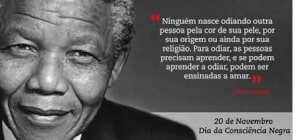Portuguese activity, suitable for high school students, with questions on reading, interpretation and text production, on the theme “Black Consciousness”.
This Portuguese language activity is available for download in an editable Word template and ready to print in PDF.
Download this Portuguese exercise at:
SCHOOL: DATE:
PROF: CLASS:
NAME:
Text I

Text II
Black running?
It's a thief...
"While blacks are, as they are, treated like second-rate meat
in a third-party butcher, Brazil will never cease to be a well of inequality and social injustice"
Andrew Petry. See, 01/26/2005
Text III
The case was practically restricted to Rio Grande do Sul, but it is so emblematic that it deserved to have crossed the borders of Rio Grande do Sul. It was like this: two black brothers, William and Cristian Flores, aged 17 and 24, were heading to the place where would take the entrance exam for mechanical engineering at the Federal University of Rio Grande do Sul, in Porto Happy. About two blocks from the building, with a few minutes to go before the gates closed, the two decided to run to avoid a delay. Halfway there, they were detained by three police officers, with a vehicle and a gun in their hands. The brothers, of course, lost the entrance exam. And why were they immediately perceived as suspicious?
Racism, why.
As a consolation, perhaps they were both badly dressed, revealing a suspicious contrast to the usual college entrance exam? Wrong. They dressed like any middle-class kid like themselves, the sons of an engineer. Maybe they were stopped by the police just because they were running, in an attitude that suggests an escape from somewhere? Wrong. Cristian, the eldest, says that, as it was late, there were "two or three" other young people running towards the gate - with the significant difference that they were all white. It is unequivocal that racism motivated the police approach, perhaps there would be the geographical consolation that this only happens in Rio Grande do Sul, a part of the country that other Brazilians imagine as being totally blond and blue-eyed and, for that very reason, less tolerant of blacks and mestizos.
Wrong again.
The most dramatic case of racism and police violence, this conjunction of which 51% of blacks Brazilians have already been victims, against only 15% of whites, it happened in February last year, in Sao Paulo. Dentist Flávio Ferreira Sant’Ana was returning from the airport, where his girlfriend had boarded, when he was mistaken for an assailant. He died with two shots fired by the police who approached him and, after the tragedy, they tried to set up the usual farce: they put a gun in the victim's hand to claim that he had resisted the arrest with gunfire. (The scene is such a recurrent vice of the degenerate portion of the police that it should certainly place Brazilians as the most reactive to the police in the world(…) Flávio Sant’Ana was murdered in the biggest, richest and most cosmopolitan city in the country by racism.
(Andre Petry)
1) What is racism? Search and present two definitions for the entry.
A:
2) According to the texts above, which social group suffers greatly from racism in the world?
A:
3) In Brazil, how is racism seen? Explain.
A:
4) What is the International Day for the Elimination of Racial Discrimination, who established this day and why?
A:
5) Based on the texts above, write a editorial. Remembering: the editorial is a text published in newspapers and magazines and aims to present facts that express the opinion of the newspaper or magazine or even their editors on a particular subject current. The sender expresses himself through formal language and aims to convince the interlocutor to believe what he is saying. The editorial is divided into three parts: the Introduction – it must portray the main idea of what will be discussed. The development (editorial body) – In this part, all the arguments are exposed, justified by comments and opinions by the newspaper itself about the subject discussed and the conclusion - which represents the closing of the ideas discussed above, that is, the appropriate solutions are usually presented to the problem raised throughout the text, as well as, instead of being guided by this aspect, it can only allow the reader to reflect on the subject matter.
Read the texts above and, based on the information provided by them and your own point of view, write an editorial that seeks to answer the questions: Is Brazil a democratic country? Is there racial democracy in our country?
By Rosiane Fernandes Silva
At answers are in the link above the header.
 report this ad
report this ad